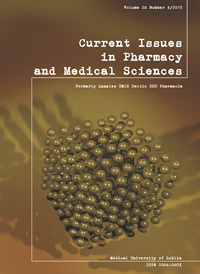Determination of free and bounded phenolic acids in the rhizomes and herb of Sanguisorba officinalis L.
DOI:
https://doi.org/10.1515/cipms-2015-0083Słowa kluczowe:
phenolic acids, Sanguisorba officinalis L., 2D-thin layer chromatographyAbstrakt
An analysis of the fractions of free acids and phenolic acids liberated by way of hydrolysis in the rhizomes and herbaceous tissues of Sanguisorba officinalis L. was conducted through utilizing the 2D-TLC method. Fifteen phenolic acids were identified. Our work showed that ellagic, protocatechuic, gentisic, p-hydroxybenzoic, syringic, vannilic and ferulic acids were common in all tested fractions, and gallic and protocatechuic acids were dominant in fractions obtained from the rhizomes, while caffeic, p-coumaric, syringic, vannilic and ferulic acids were abundant in the herbaceous tissues. However, α and β - resorcylic acids were detected only in rhizome phenolic acid fractions liberated from their conjunction with sugars and alcohols. Furthermore, chlorogenic acid was present only in a free form in the herbaceous tissues, while p-hydroxyphenylacetic acid was liberated from conjunction from a herbaceous extract.
Bibliografia
1.1. Amarowicz R, Pegg RB.: Legumes as a source of natural antioxidants. Eur. J. Lipid Sci. Tech., 110, 865, 2008.
2. Ban J.Y. et al.: Neuroprotective properties of gallic acid from Sanguisorbae Radix on amyloid β Protein (25-35)-induced toxicity in cultured rat cortical neurons. Biol. Pharm. Bull., 31, 149, 2008.
3. Cieśla Ł.M. et al.: Thin-layer chromatography coupled with biological detection to screen natural mixtures for potential drug leads. Phytochem. Lett., 11, 445, 2015.
4. Hu J. et al.: Nordammarane triterpenoids from Sanguisorba officinalis. Helvet. Chim. Acta, 98, 273, 2015.
5. Ibrahim R.K., Towers G.H.: Identification by chromatography of plant phenolic acids. Arch. Biochem. Biophys., 87, 125, 1960.
6. Jo S.et al.: Anti-inflammatory effects of Sanguisorbae Radix on contact dermatitis induced by dinitrofluorobenzene in mice. Chin. J. Int. Med., in press (2015).
7. Krzaczek T.: Fenolokwasy w rożnych surowcach garbnikowych z rodziny Rosaceae. Farm. Pol., 40, 475, 1984.
8. Nguyen T.T.H. et al.: Neuroprotective effect of Sanguisorbae radix against oxidative stress-induced brain damage: In vitro and in vivo. Biol. Pharm. Bull., 31, 2028, 2008.
9. Oh H. et al.: Sanguisorbae radix protects against 6-hydroxydopamine- induced neurotoxicity by regulating NADPH oxidase and NF-E2-related factor-2/heme oxygenase-1 expressions. Phytother. Res., 27, 1012, 2013.
10. Pelc M. et al.: Chemical variability of great burnet (Sanguisorba officinalis L.) growing wild in Poland. Acta Hort., 925, 97, 2011.
11. Schmidtlein H., Herrmann K.: Quantitative analysis for phenolic acids by thin layer chromatography. J. Chromatogr., 115, 123, 1975.
12. Shun Wan C et al.: Antioxidant activity of Chinese medicinal herbs. Pharm. Biol., 46, 587, 2008.
13. Smolarz H.D., Waksmundzka-Hajnos M.: Two-dimensional TLC of phenolic acids on cellulose J. Planar Chromatogr., 6, 278, 1993.
14. Sokołowska-Krzaczek A., Skalicka-Woźniak K., Czubkowska A.: Variation of phenolic acids from herb and roots of Salsola kali L. Acta Soc. Bot. Polon., 78, 197, 2009.
15. Sun L.L. et al.: Chemical constituents from charred Sanguisorbae Radix. Chin. Trad. Herb. Drugs, 44, 646, 2013.
16. Yokozawa T. et al.: A study on the nitric oxide production-suppressing activity of Sanguisorbae Radix components. Biol. Pharm. Bull., 23, 717, 2000.
17. Yokozawa T., Chen, P.C. Evidence suggesting a nitric oxide-scavenging activity for traditional crude drugs, and action mechanisms of Sanguisorbae Radix against oxidative stress and aging. J. Am. Aging Assoc., 24, 19, 2001.
18. Zhang S. et al.: Isolation and identification of the phenolic compounds from the roots of Sanguisorba officinalis L. and their antioxidant activities. Molecules, 17, 13917, 2012.
Pobrania
Opublikowane
Numer
Dział
Licencja
Prawa autorskie (c) 2015 Autorzy

Praca jest udostępniana na licencji Creative Commons Attribution-NonCommercial-NoDerivatives 3.0 Unported License.


